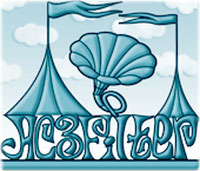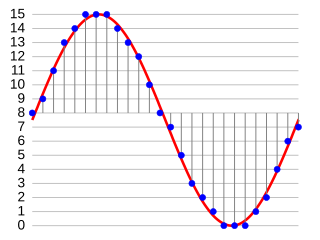 W
WAn A-law algorithm is a standard companding algorithm, used in European 8-bit PCM digital communications systems to optimize, i.e. modify, the dynamic range of an analog signal for digitizing. It is one of two versions of the G.711 standard from ITU-T, the other version being the similar μ-law, used in North America and Japan.
 W
WAC3Filter is a free DirectShow filter for real time audio decoding and processing. It can decode the audio formats AC3, DTS, and MPEG Multichannel.
 W
WADX is a lossy proprietary audio storage and compression format developed by CRI Middleware specifically for use in video games; it is derived from ADPCM. Its most notable feature is a looping function that has proved useful for background sounds in various games that have adopted the format, including many games for the Sega Dreamcast as well as some PlayStation 2, GameCube and Wii games. One of the first games to use ADX was Burning Rangers, on the Sega Saturn. Notably, the Sonic the Hedgehog series from the Dreamcast generation up to at least Shadow the Hedgehog have used this format for sound and voice recordings.
 W
WaptX is a family of proprietary audio codec compression algorithms owned by Qualcomm, with a heavy emphasis on wireless audio applications.
 W
WDolby Headphone is a technology developed by Lake Technology (Australia), that later sold marketing rights to Dolby Laboratories, sometimes referred to as Mobile Surround, which creates a virtual surround sound environment in real-time using any set of two-channel stereo headphones. It takes as input either a 5.1 or a 7.1 channel signal, a Dolby Pro Logic II encoded 2 channel signal or a stereo 2 channel signal. It sends as output a 2 channel stereo signal that includes audio cues intended to place the input channels in a simulated virtual soundstage.
 W
WDolby Laboratories, Inc. is an American company specializing in audio noise reduction and audio encoding/compression. Dolby licenses its technologies to consumer electronics manufacturers.
 W
WDTS, Inc. is an American company that makes multichannel audio technologies for film and video. Based in Calabasas, California, the company introduced its DTS technology in 1993 as a higher-quality competitor to Dolby Laboratories, incorporating DTS in the film Jurassic Park (1993). The DTS product is used in surround sound formats for both commercial/theatrical and consumer-grade applications. It was known as The Digital Experience until 1995. DTS licenses its technologies to consumer electronics manufacturers.
 W
WECMA-407 is the world's first approved international 3D audio standard for the unrestricted delivery of channel-based, object-based and scene-based signals up to NHK 22.2 developed by Ecma TC32-TG22 in close cooperation with France Télévisions, Radio France, École Polytechnique Fédérale de Lausanne and McGill University in Montreal.
 W
WElecard is a technology company that provides software products for video and audio encoding, decoding, processing, receiving and transmission.
 W
WG.711 is a narrowband audio codec originally designed for use in telephony that provides toll-quality audio at 64 kbit/s. G.711 passes audio signals in the range of 300–3400 Hz and samples them at the rate of 8,000 samples per second, with the tolerance on that rate of 50 parts per million (ppm). Non-uniform (logarithmic) quantization with 8 bits is used to represent each sample, resulting in a 64 kbit/s bit rate. There are two slightly different versions: μ-law, which is used primarily in North America and Japan, and A-law, which is in use in most other countries outside North America.
 W
WG.722 is an ITU-T standard 7 kHz wideband audio codec operating at 48, 56 and 64 kbit/s. It was approved by ITU-T in November 1988. Technology of the codec is based on sub-band ADPCM (SB-ADPCM). The corresponding narrow-band codec based on the same technology is G.726.
 W
WG.722.1 is a licensed royalty-free ITU-T standard audio codec providing high quality, moderate bit rate wideband (50 Hz – 7 kHz audio bandwidth, 16 ksps audio coding. It is a partial implementation of Siren 7 audio coding format developed by PictureTel Corp.. Its official name is Low-complexity coding at 24 and 32 kbit/s for hands-free operation in systems with low frame loss. It uses a modified discrete cosine transform audio data compression algorithm.
 W
WHigh-Efficiency Advanced Audio Coding (AAC-HE) is an audio coding format for lossy data compression of digital audio defined as an MPEG-4 Audio profile in ISO/IEC 14496-3. It is an extension of Low Complexity AAC (AAC-LC) optimized for low-bitrate applications such as streaming audio. The usage profile AAC-HE v1 uses spectral band replication (SBR) to enhance the modified discrete cosine transform (MDCT) compression efficiency in the frequency domain. The usage profile AAC-HE v2 couples SBR with Parametric Stereo (PS) to further enhance the compression efficiency of stereo signals.
 W
WLDAC is a proprietary audio coding technology developed by Sony, which allows streaming high-resolution audio over Bluetooth connections at up to 990 kbps at 32 bit/96 kHz. It is used by various Sony products, including headphones, smartphones, portable media players, active speakers and home theaters.
 W
WMP3 Surround is an extension of MP3 for multi-channel audio support including 5.1 surround sound. It was developed by Fraunhofer IIS in collaboration with Thomson and Agere Systems, and released in December 2004.
 W
WMPEG-2 is a standard for "the generic coding of moving pictures and associated audio information". It describes a combination of lossy video compression and lossy audio data compression methods, which permit storage and transmission of movies using currently available storage media and transmission bandwidth. While MPEG-2 is not as efficient as newer standards such as H.264/AVC and H.265/HEVC, backwards compatibility with existing hardware and software means it is still widely used, for example in over-the-air digital television broadcasting and in the DVD-Video standard.
 W
WThe μ-law algorithm is a companding algorithm, primarily used in 8-bit PCM digital telecommunication systems in North America and Japan. It is one of two versions of the G.711 standard from ITU-T, the other version being the similar A-law. A-law is used in regions where digital telecommunication signals are carried on E-1 circuits, e.g. Europe.
 W
WSony Dynamic Digital Sound is a cinema sound system developed by Sony, from which compressed digital sound information is recorded on both outer edges of the 35 mm film release print. The system supports up to eight independent channels of sound: five front channels, two surround channels and a single sub-bass channel. The eight channel arrangement is similar to large format film magnetic sound formats like Cinerama and Cinemiracle. The five front channels are useful for very large cinema auditoriums where the angular distance between center and left/right channels may be considerable. SDDS decoders provide the ability to downmix to fewer channels if required.
 W
WWALTR direct converter is proprietary software developed by Softorino for converting and transferring music, video, ringtone, and PDF files directly onto Apple iOS devices with limited support of non-iOS devices.